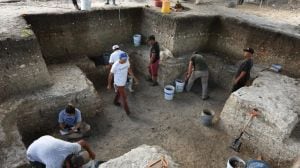Born with a passport
George-Jordan Dimbo is top to toe the Irish lad. He studies Gaelic, eats rashers, plays hurling, prays to the saints, papers his walls...

George-Jordan Dimbo is top to toe the Irish lad. He studies Gaelic, eats rashers, plays hurling, prays to the saints, papers his walls with parochial school awards, and spends Saturdays at the telly watching Dustin the Turkey, a wisecracking puppet mock the powerful.
If the Irish government has its way, he may soon be living in Africa. George, 11, is an Irish citizen and has been since his birth when Ireland, alone in Europe, still gave citizenship to anyone born on its soil. His mother and father, Ifedinma and Ethelbert Dimbo, are illegal immigrants from Nigeria, who brought him back to Ireland three years ago, judging it the best place to raise him.
Since then, the unusual trio—the Irish schoolboy and his African parents—have shared a room in a worn Dublin hostel while facing a prospect dreaded by children on both sides of the Atlantic, a parent’s deportation.
“Dear justice minister,” George wrote when he was 9. “I heard my Mommy and Daddy whispering about deportation. Please do not deport us. Remember, I am also an Irish child.”
Thousands of Irish children face similar risks, living in a country where one or both parents do not legally reside. Their stories find parallels in the United States, where an estimated five million children—including three million American citizens—have parents who are illegal immigrants. New efforts to catch them make fear of deportation a growing factor in American life, the flip side of generous laws that make infants instant citizens.
Ireland’s dash to diversity has so far provoked little of the conflict found elsewhere in Europe or the United States. There are no major anti-immigrant political parties and little anti-immigrant violence. When a Dublin high school student, Olukunle Elukanlo, was deported to Nigeria in 2005, his protesting classmates won his return.
The battle over the “I.B.C.s”—Irish-born children—stems from a decade of head-turning change that has brought this island of red-haired Marys and blue-eyed Seans the demographic version of an extreme makeover. For centuries, Ireland was a racially homogenous land of emigrants. Now it is a multicultural nation of immigrants, whose share of the population, 11 per cent, is nearly as high as that in the United States.
Years of Irish prosperity have drawn Polish plumbers, Lithuanian nannies, Latvian farm workers, Filipino nurses, Chinese traders, and sub-Saharan asylum seekers. The town of Portlaoise, about 40 miles southwest of Dublin, has the country’s first African-born mayor.
“I went to bed in one country and woke up in a different one,” writes the Irish novelist, Roddy Doyle, in a collection of short stories called The Deportees. They depict characters as diverse as an African war survivor on his first day of class, and Fat Gandhi, a gay tandoori vendor who “quickly realised that his loud embrace of Christianity was very good for business.”
The Dimbos are the kind of memorable figures who might have tumbled from Mr. Doyle’s pages. A former graduate student in Cork, Ms. Dimbo, 42, wore a Yoruba headdress to a recent parent-student event, and has just written a feminist novel about a migrant prostitute. Mr. Dimbo, 43, releases his frustrations with a daily run through the Dublin streets, and George is so unusually courteous that his sixth-grade teacher thought he was “taking the mickey”–Irish for pulling his leg.
“He’s the most mannerly child I’ve taught in years,” said the teacher, Brendan O’Boyle. “He’s very, very good, very upright, very honest.”
Not long after George arrived, a classmate told him that he disliked black people. “But I’m black,” George recalls answering. “No,” the boy said. “You’re Irish.”






- 01
- 02
- 03
- 04
- 05

























